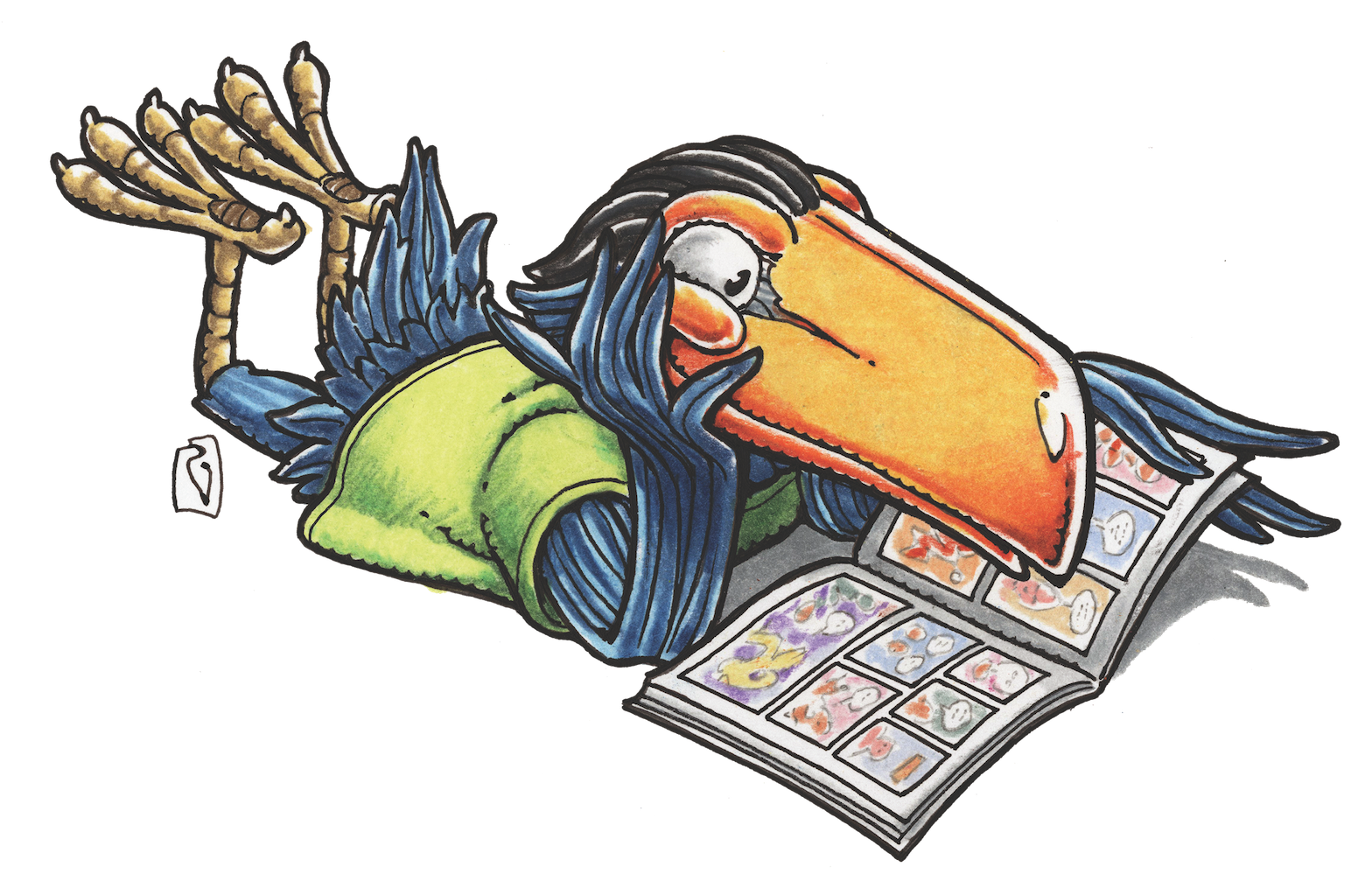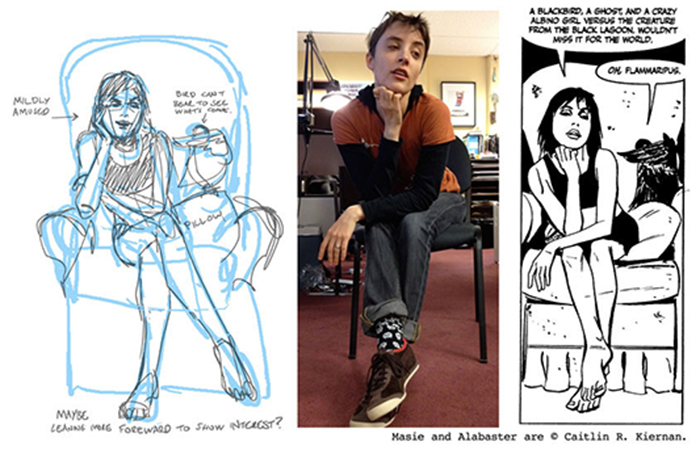WORKING SMARTER
Dilettante 004: Using Photo Reference


When I was in art school, I was an ignorant fool.
Somehow, I’d gotten the idea in my head that real artists don’t use photo reference. I put a lot of energy into crafting bulletproof arguments that looking at photos when you draw would compromise your true vision, and turn you from an artist into a swipe-hack. I chided my fellow students when they pulled out a camera or (even worse) worked from a photo someone else took. I nagged them and shamed them.
And for almost a decade after graduating, i avoided using photo reference myself. Once in a while, I’d succumb to deadline pressure and take photos to solve a problem, but by and large, I spent the ‘90s and the beginning of the ‘00s constructing everything I drew out of my own head, or from poses I’d do myself in the mirror.
At a certain point, however, I started to realize that I had plateaued. My work wasn’t getting any better, and I was repeating characters and poses from project to project. Basically—there’s no way to say this without sounding like an arrogant jerk—I got tired of not being as good as artists I thought I was better than. I asked myself, what do my peers do that I don’t?
One big answer was that they took the time to shoot photo reference.
It wasn’t just my peers, though. I spoke to more artists and gradually found out how many of my heroes and influences used photos. If Neal Adams, Al Williamson, P. Craig Russell, and Alex Raymond all thought photo reference was valuable, maybe I shouldn’t be rejecting it out of hand.
So I started acquiring props and shooting more photos, and my work started getting better. My art still looked like I drew it, but my faces and poses were showing some freshness and variety, my settings were more convincing—and the pages were coming out faster, too.
That last point is key. Comics are almost always drawn on some sort of deadline, and a cartoonist needs to generate a lot of work to earn anything resembling a decent living. Even if you have the raw skill to produce great work without using photos, you’re going to hamstring your career if you reject a tool that could significantly improve your productivity.
That doesn’t mean having a bunch of photos on your desk (or screen) is a magic bullet, though. You can surround yourself with useful reference and still turn out terrible pages. As with any powerful tool, there are pitfalls for people who don’t use it thoughtfully. You can’t just trace a photo and expect to get a decent panel out of it. When you lay out a page, every element that goes into it needs to be carefully chosen. The odds against you shooting or finding the perfect photo for a panel are slim.
Here are some things to keep in mind so you can make the most out of using photo reference.
• Camera lenses can introduce distortions that look bizarre when translated to line art. Learn to recognize these distortions and how to correct them. As a general rule, the further you are from your subject when you shoot your photo, the better. If you want exaggerated foreshortening, you’ll get better results if you start with an unexaggerated photo or two and use them to make your invented foreshortening more convincing.
• Comics storytelling often calls for a sort of exaggerated clarity in the “acting” that can look hammy and weird when people try to do it in real life. Conversely, reference taken from normal social situations can look flat or inexpressive on the page. So you’ll rarely find the right pose or expression in other people’s photos, and you may have a tough time getting your models to produce them for your own.
Some cartoonists, like Alison Bechdel and my studiomate Erika Moen, use a camera with a timer and pose for almost all of their reference themselves, since they know what each panel needs better than any model could. Your artist peers will often be much better models than anyone else you can find to pose for you; cartoonists understand the exaggeration that even an understated panel requires to read properly.

I love working with Dylan because she’s a terrific actress and always manages to add something extra to whatever I’ve come up with in my layouts.
Go take a look at her work at https://dylanmeconis.com.
Even if the pose your model takes is nearly perfect, you’ll find still need to nudge the frozen moment you’ve captured into something that has the tension and rhythm of observed reality. I’ve found that doing regular life drawing helps with this, but just following your instincts as a cartoonist can get you there too. Make a gesture drawing or sketch of the pose before you take or use the photo reference; even if it’s anatomically inaccurate, it will remind you of the spirit you’ll need to capture in your final drawing.
• It helps if your model wears something close to what your character is wearing. But your models’ real life clothing will have dozens of incidental folds and wrinkles that, if copied faithfully, will clutter up your drawing. Analyze what the fabric is doing and how the clothing is constructed. Then simplify it to the most important lines for your drawing.
• Don’t depict your main character as a stylized, invented figure in one panel, then follow that with a closely referenced photoswipe of a movie actor. If you do, you’re going to ruin your reader’s immersion in the story. Maintain a consistent style and level of detail between referenced and unreferenced panels. If you work in a style that varies in how detailed the art is from panel to panel (as in a lot of manga), let the story – not the presence of a reference photo – be the thing that dictates whether a panel is simple or elaborate.
• If you’re depicting light and shadow in your comic, try to carefully arrange the light on your models to get form-defining shadows. A camera’s built-in flash rarely lights a figure in a way an artist will find useful in drawing a comic.
• If you’re combining several reference photos to form a single image, try to shoot all of your reference for that image from a consistent eye level. When the eye levels vary, you’ll need to redraw the various elements in your panels to make them work together.
• If you find yourself using reference for every panel of every page, spending hours searching for or editing reference to get it “just right” before drawing a single line, or otherwise avoiding/slowing down your own work instead of speeding it up, then you’re using reference as a crutch, not as a tool. Limit your use of photo reference to things that speed up your normal process or improve your mental library of environments and poses.
There’s a lot of useful information in a photo that can improve your work, and even more that could make it worse. Learn to extract everything useful and discard everything else.
Using photos effectively is not the easiest thing to learn and will differ depending on each artist’s needs and methods, but i hope this is a good start.
Steve Lieber’s Dilletante column appears the second Tuesday of every month on Toucan. Want to share your opinions on this? Steve is on Twitter at @steve_lieber and on Facebook at http://www.facebook.com/steve.lieber